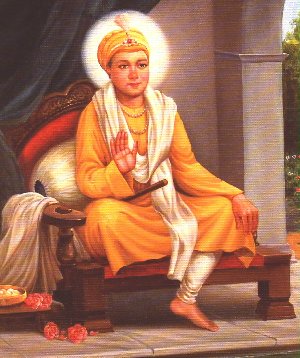Template:Today's featured article: Difference between revisions
Navroopsehmi (talk | contribs) |
Hari singh (talk | contribs) |
||
| Line 1: | Line 1: | ||
==[[ | ==[[Guru Har Krishan]]== | ||
[[Image: | [[Image:Guru harkrishan.jpg|thumb|''Guru Har Krishan Ji''|right]] | ||
The | '''The Sikhs this month celebrate the 349th birth anniversary of their eight [[Guru]], Guru Har Krishan Ji - also fondly called "Bala Guru" as Guru ji became Guru at a young age of only 5 years old.''' | ||
Every year during late July, huge celebrations are held at Gurdwara [[Bangla Sahib]] in Delhi, India to commemorate this auspicious day. It was at this location in Delhi where Guru ji stayed with Raja Jai Singh during the reign of Mughal Emperor Aurangzeb. | |||
'''Guru Har Krishan Ji''' ([[7 July]] [[1656]] - [[30 March]] [[1664]]) was the eighth of [[the Ten Gurus of Sikhism]] and became Guru on [[7 October]] [[1661]] following in the footsteps of his father, [[Guru Har Rai]] Ji. Before Guru Ji died, he nominated [[Baba Bakala]] Ji, as the next Guru of the Sikhs. It turns out that this was his granduncle [[Guru Teg Bahadur]] Ji. The following is a summary of the main highlights of Guru Ji short life: | |||
'''[[ | |||
#When Guruji stayed in Delhi there was a smallpox epidemic and many people were dying. By Guruji blessing, the lake at Bangla Sahib provided cure for thousands. | |||
#Gurdwara Bangla Sahib was constructed in Guruji memory. This is where he stayed during his visit to Delhi. | |||
# Guru Sahib got the unlettered water-carrier named Chhaju Ram to expound the philosophy of the holy Gita on the challenge from Pandit Lal Chand. On hearing this narration of the holy Gita, Pandit Lal Chand was much humiliated. He was so impressed with this feat performed by the Guru that he became a Sikh and later escorted the Guru Sahib up to Kurukashatra. | |||
#Also Gurdwara Bala Sahib was built, where Guruji was cremated at the age of about 7 years and 8 month. | |||
'''[[Guru Har Krishan|....Continued]]''' | |||
Revision as of 04:00, 25 July 2005
Guru Har Krishan
The Sikhs this month celebrate the 349th birth anniversary of their eight Guru, Guru Har Krishan Ji - also fondly called "Bala Guru" as Guru ji became Guru at a young age of only 5 years old. Every year during late July, huge celebrations are held at Gurdwara Bangla Sahib in Delhi, India to commemorate this auspicious day. It was at this location in Delhi where Guru ji stayed with Raja Jai Singh during the reign of Mughal Emperor Aurangzeb.
Guru Har Krishan Ji (7 July 1656 - 30 March 1664) was the eighth of the Ten Gurus of Sikhism and became Guru on 7 October 1661 following in the footsteps of his father, Guru Har Rai Ji. Before Guru Ji died, he nominated Baba Bakala Ji, as the next Guru of the Sikhs. It turns out that this was his granduncle Guru Teg Bahadur Ji. The following is a summary of the main highlights of Guru Ji short life:
- When Guruji stayed in Delhi there was a smallpox epidemic and many people were dying. By Guruji blessing, the lake at Bangla Sahib provided cure for thousands.
- Gurdwara Bangla Sahib was constructed in Guruji memory. This is where he stayed during his visit to Delhi.
- Guru Sahib got the unlettered water-carrier named Chhaju Ram to expound the philosophy of the holy Gita on the challenge from Pandit Lal Chand. On hearing this narration of the holy Gita, Pandit Lal Chand was much humiliated. He was so impressed with this feat performed by the Guru that he became a Sikh and later escorted the Guru Sahib up to Kurukashatra.
- Also Gurdwara Bala Sahib was built, where Guruji was cremated at the age of about 7 years and 8 month.

